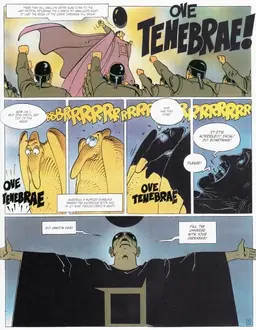Parallels between The Sundiata Epic and The Lord of The Rings
Sundiata was a 13th-century emperor of the Empire of Mali. He was the son of King Maghan and his second wife Sogolon. Mansa Sundiata is a historical figure surrounded by many legends. The Sundiata Epic has been passed down through the centuries by the griots, oral historians of the Mandingo people. Although there are a number of slightly different versions of the Sundiata epic, all agree he was the rightful heir to his father's throne, but had to go into exile because of the jealous machinations of his father's first wife Sassouma Berete. Eventually, he returned to reclaim his kingdom by defeating the mighty sorcerer-king Soumaoro.
The Lord of the Rings is a modern fable composed in the 20th century, but which draws on earlier European myths to create a fantasy world set in an imaginary antiquity. In the Lord of the Rings, Aragorn, the exiled heir to the throne of Gondor, seeks to regain his throne and defeat Sauron, an evil spirit and mighty sorcerer.
No known relationship exists between the medieval African epic of Sundiata and the modern European story of The Lord of the Rings, which makes the following parallels all the more remarkable.
The hero is born to a youthful mother significantly younger than her husband
Sundiata Epic
Sundiata's mother Sogolon was described as a 'young girl' when she married King Maghan as his second wife. The King had been "reigning many years" and already had an 8-year-old son. Sundiata was conceived shortly after the marriage of his parents. 1
Lord of the Rings
When Aragorn's parents wedded, Aragorn's mother Gilraen was "young and had not reached the age at which the women of the Dunedain were accustomed to marry" while his father Arathorn was "a stern man of full age". Aragorn was born less than two years after his parents' marriage. 2
The marriage of the hero's parents was precipitated by the prophecy of their future son's greatness
Sundiata Epic
A hunter visiting Maghan's court prophesied of the arrival of Sogolon, saying "This is the woman you must marry, sire, for she will be the mother of him who will make the name of Mali immortal forever." The marriage would not have occured otherwise, for Sogolon was hideously ugly. 3
Lord of the Rings
Dirhael, the maternal grandfather of Aragorn, initially opposed the idea of marrying his daughter to Arathorn but Dirhael's wife prophesied, "If these two wed now, hope may be born for our people; but if they delay, it will not come while this age lasts."4
The hero's father dies while the hero is still a child
Sundiata Epic
King Maghan passed away when Sundiata was seven. 5
Lord of the Rings
Arathorn died when Aragorn was two years old.6
The hero is the heir to the throne but leaves his kingdom and goes into exile so as not to become the target of his enemy's sorcery
Sundiata Epic
Sundiata was the designated heir but the kingship was usurped by his older half-brother after their father's death. Knowing that the Queen Mother would use sorcery to harm Sundiata's younger siblings, Sundiata's mother and her children left Mali. 7
Lord of the Rings
Aragorn was born into an exiled race, the Dunedain, who were the remnants of the fallen kingdom of Arnor. As the hereditary chieftain of the Dunedain, he was a direct descendent ot King Isildur and therefore rightful heir to the throne of Arnor's sister-realm Gondor. But this lineage was kept secret because Sauron the Enemy "was seeking to discover the Heir of Isildur".8
The hero's mother dies before seeing her son on the throne
Sundiata Epic
Before Sundiata's war on Soumaoro, Sundiata's mother Sogolon passed away while in exile in Mema. 9
Lord of the Rings
Aragorn's mother also passed away years before his war with Sauron. 10
The hero's kingdom is threatened by a powerful sorcerer bent on world domination
Sundiata Epic
Soumaoro, the sorcerer-king of Sosso, was described as "an evil demon" whose reign "produced nothing but bloodshed". He ruled over a 'vast empire' and 'defied the whole world'. Already a king of many kings, he sought to take Mali by force.11
Lord of the Rings
Sauron the Necromancer sought to bring the remaining free realms of Middle Earth under his rule by unleashing his armies against them. Sauron was an evil spirit whose physical realm covered the east and south of Middle Earth. He "strove ever for the dominion of Middle Earth, to become a king over all kings".12
The sorcerer had under his control 9 dead/undead kings
Sundiata Epic
Soumaoro had "defeated nine kings whose heads served him as fetishes in his macabre chamber".13
Lord of the Rings
Sauron ensnared nine human kings by giving them enchanted rings and turning them into ringwraiths, 'shadows' who served his will.14
The sorcerer's stronghold is a tower
Sundiata Epic
Soumaoro lived in the highest storey of a tower in the middle of his stronghold Sosso, which he fortified with a triple curtain wall.15
Lord of the Rings
Sauron's abode was the Tower of Baraddur which he build in the fortified land of Mordor.16
The sorcerer is closely associated with the art of smithing
Sundiata Epic
Soumaoro's followers were smiths - Sosso was "the city of smiths skilled in wielding the spear". 17
Lord of the Rings
In addition to sorcery, Sauron's other main occupation was forging.18
The sorcerer is almost invincible; his sole vulnerability lies in one magic object
Sundiata Epic
Soumaoro's flesh was inpenetrable and therefore he couldn't be killed in battle. The only thing that could destroy his supernatural powers was his 'tana' - the spur of a white cock. 19
Lord of the Rings
Sauron put the greater part of his power into the One Ring. When the Ring was destroyed, the realm of Sauron instantly self-destructed.20
The hero forges an alliance of different kingdoms to overthrow the sorcerer
Sundiata Epic
The armies of Mema, Wagadou and Tabon formed Sundiata's first allied force against Soumaoro. They were later joined by other kingdoms.21
Lord of the Rings
The armies of Rohan and Gondor jointly defended Gondor from Sauron's onslaught. They had the aid of the Wild Men of the Woods. The combined army was also joined by the Dunedain and the Company of the Dead.
The sorcerer was defeated by a combination of external forces assaulting his armies and an infiltrator inside his stronghold
Sundiata Epic
Nana Triban, daughter of Sassouma and the half-sister of Sundiata, was sent to Sosso to be one of Soumaoro's numerous wives. She gained the confidence of the sorcerer-king and drew from him the secret of his power. Nana Triban later escaped Sosso and fled to her brother Sundiata. Using the information she gave him, Sundiata prepared a magic arrow tipped with Soumaoro's tana which he used to defeat the sorcerer in battle. With the defeat of their king, Soumaoro's forces were routed.22
Lord of the Rings
The hobbits Frodo and Sam gained entry to Sauron's fortress Mordor and threw the ring into the fires of Mount Doom. At the moment the ring was destroyed, their friends were battling the armies of Sauron outside the gates of Mordor. The destruction of the ring instantly turned the battle in the allied armies' favor as the creatures of Sauron turned and fled.23
The hero-king reinstates his allies to their kingdoms
Sundiata Epic
After the allied victory, 12 kings struck their spears into the ground before Sundiata, acknowledging him as their Emperor. Sundiata pulled each of the spears out of the ground in turn, presenting the spear to its owner with the proclamation, "I give you back your kingdom, king of ..."24
Lord of the Rings
After the defeat of Mordor, King Aragorn gave the hereditary steward of Gondor the princedom of Ithilien and made a proclamation 'giving' full sovereignty over the Forest of Druadan to the Wild Men who lived there.25
The numerous similarities between the two stories does not necessarily prove that Lord of the Rings drew inspiration from the earlier Sundiata Epic.The acknowledged influences on Lord of the Rings are European myths, but even so, the similarities between Lord of the Rings and its European inspirations are NOT the same as the similarities between Lord of the Rings and the Sundiata Epic. (See The influence of European mythology on Tolkien's Tales.) When the two heroes' journeys are stripped down to their bare elements, what remains is a narrative that could have taken place anywhere in the world. It is not at all impossible that story tellers in different cultures sometimes take the same paths without knowing of each other.
[The edition of Lord of The Rings used as reference for this article is the Paperback Edition published by Houghton Mifflin. The edition of The Silmarillion used as a reference for this article is the Paperback Edition published by Ballatine Books.]
Notes:
D.T. Niane, Sundiata: An Epic of Old Mali, pp. 5-12
J.R.R. Tolkien, The Lord of the Rings, p. 1032
D.T. Niane, pp. 6-7
Tolkien, The Lord of the Rings, p. 1032
Niane, p. 18
Tolkien, The Lord of the Rings, p. 1032
Niane, pp. 26-28
Tolkien, The Lord of the Rings, pp. 1018-1019, 1032
Niane, p. 46
Tolkien, The Lord of the Rings, p. 1036
Niane, pp. 41-42
Tolkien, The Silmarillion, pp. 363, 330
Niane, p. 41
Tolkien, The Lord of the Rings, p. 50
Niane, p. 38
Tolkien, The Silmarillion, p. 330
Niane, p. 67
Tolkien, The Silmarillion, p. 363
Niane, pp. 62, 65
Tolkien, The Lord of the Rings, pp. 51,928
Niane, pp. 51, 54
Niane, pp. 57-58, 65
Tolkien, The Lord of the Rings, p. 929
Niane, pp. 75-77
Tolkien, The Lord of the Rings, pp. 948, 954













 .
.